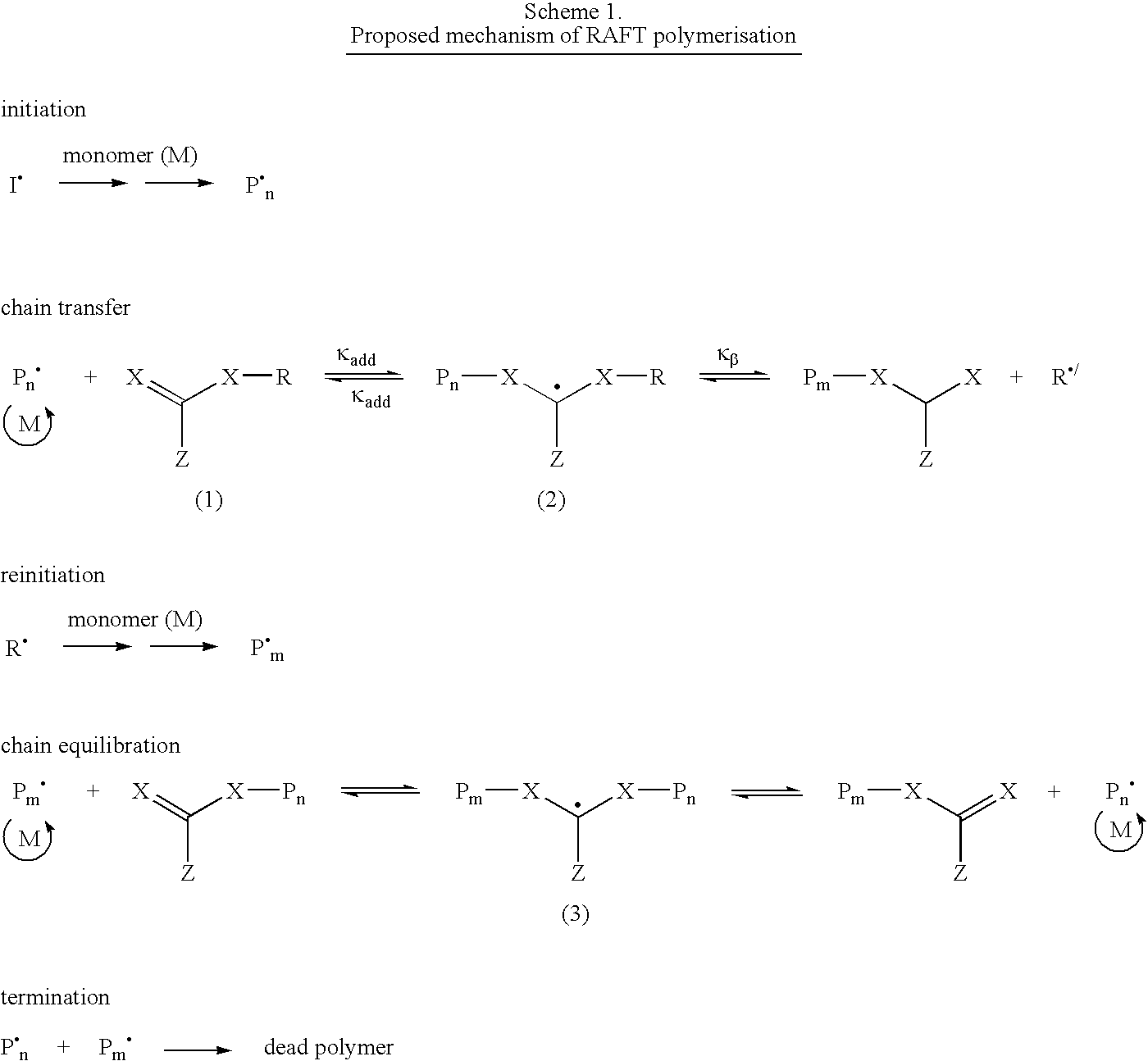Aqueous dispersions of polymer particles
a technology of polymer particles and dispersions, applied in the field of aqueous dispersions of polymer particles, can solve the problems of adversely affecting the surface properties of the film, limited control capacity, and limited control capacity of current emulsion polymerisation technology, so as to promote stain resistance to a paint film, reduce the amount of conventional surfactant, and minimise the negative effect of surfactan
- Summary
- Abstract
- Description
- Claims
- Application Information
AI Technical Summary
Benefits of technology
Problems solved by technology
Method used
Image
Examples
example 1
Synthesis of 2-[(2-phenylethanethioyl)sulfanyl]propanoic Acid (20)
[0150]
[0151] A solution of benzylmagnesium chloride in ether (1.0 M, 40 mL, 40 mmol) was added slowly with stirring to an ice-cooled solution of carbon disulfide (4.0 mL, 66 mmol) in dry tetrahydrofuran (40 mL) under nitrogen. After 30 min, 2-bromopropanoic acid (3.6 mL, 6.2 g, 40 mmol) was added and the reaction was stirred at ambient temperature. After 48 h, the mixture was poured into ethyl acetate (200 mL) and washed with water (3×100 mL), followed by saturated sodium chloride solution (100 mL). The organic layer was dried (magnesium sulfate) and evaporated. The remaining liquid was distilled (120° / 0.13 Pa, Kugelrohr) to remove unreacted 2-bromopropanoic acid. The residue was then dissolved in ether (200 mL) and extracted with 5% sodium bicarbonate solution (4×50 mL). The combined aqueous extracts were washed with ether (100 mL), then acidified to pH<1 with 2 M hydrochloric acid. The resulting mixture was extract...
example 1a
Preparation of a poly(acrylic acid)-block-poly(butyl acrylate) Macro-RAFT Agent with Respective Degrees of Polymerization n≈5 and n≈20 Using 2-[(2-phenylethanethioyl)sulfanyl]propanoic Acid (20) from Example 1
[0152] A solution of 2-[(2-phenylethanethioyl)sulfanyl]propanoic acid (20) (0.416 g, 1.73 mmol), 4,4′-azobis(4-cyanopentanoic acid), (95 mg, 0.30 mmol) and acrylic acid (0.624 g, 8.78 mmol) in THF (5.0 g) in a 50 mL round bottomed flask was stirred magnetically and sparged with nitrogen for 15 min. The flask was then heated at 85° for 2 h. At the end of this period, butyl acrylate (4.50 g, 35 mmol) was added to the flask and heating was continued at 850 for a further 3 h. The resulting diblock copolymer showed molecular weight characteristics consistent with formation under RAFT control. The copolymer solution had 54.3% solids.
example 1b
Preparation of a poly(butyl acrylate-co-methyl methacrylate) Latex Using the Macro-RAFT Agent from Example 1a
[0153] 4,4′-Azobis(4-cyanopentanoic acid), (25 mg, 0.08 mmol), diblock copolymer solution from Example 1a (5.96 g of solution; containing 3.23 g, 1.02 mmol of macro-RAFT agent), water (48.0 g) and sodium hydroxide (0.12 g, 3.0 mmol) were placed in a 100 mL round bottomed flask and stirred magnetically while being sparged with nitrogen for 15 min, then heated at 85° with continued stirring. After 15 min a mixture of methyl methacrylate (19.5 g, 0.195 mol) and butyl acrylate (19.5 g, 0.152 mol), was added in portions at 45 min intervals with the following weights added at each step: 4 g, 5 g, 6 g, 7 g, 8 g, 9 g. After the last addition, the reaction was held at 85° for a further 3 h and then allowed to cool. The latex was 45% solids and had a number average particle size of 40 nm (CHDF).
PUM
| Property | Measurement | Unit |
|---|---|---|
| degree of polymerisation | aaaaa | aaaaa |
| number average particle size | aaaaa | aaaaa |
| weights | aaaaa | aaaaa |
Abstract
Description
Claims
Application Information
 Login to View More
Login to View More - R&D
- Intellectual Property
- Life Sciences
- Materials
- Tech Scout
- Unparalleled Data Quality
- Higher Quality Content
- 60% Fewer Hallucinations
Browse by: Latest US Patents, China's latest patents, Technical Efficacy Thesaurus, Application Domain, Technology Topic, Popular Technical Reports.
© 2025 PatSnap. All rights reserved.Legal|Privacy policy|Modern Slavery Act Transparency Statement|Sitemap|About US| Contact US: help@patsnap.com



